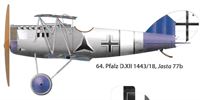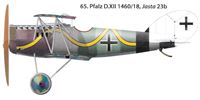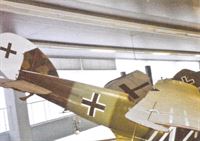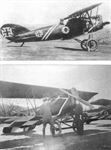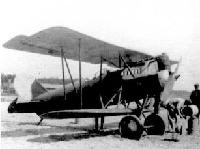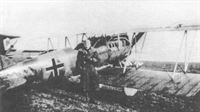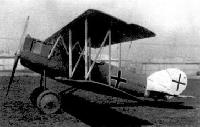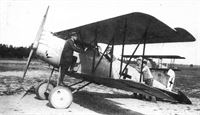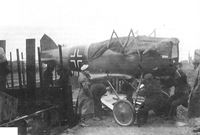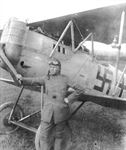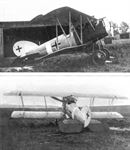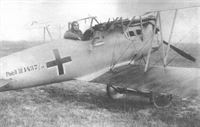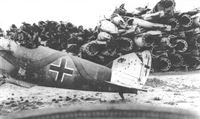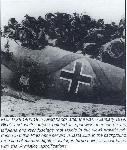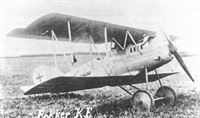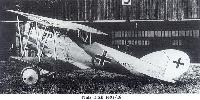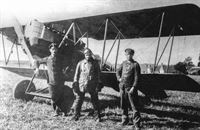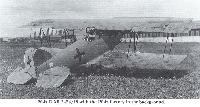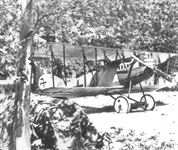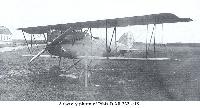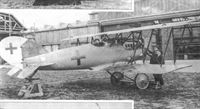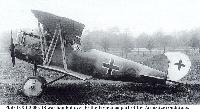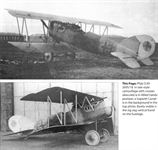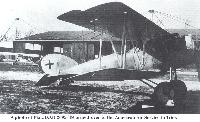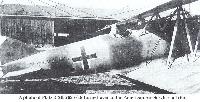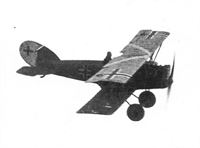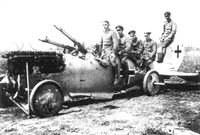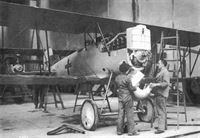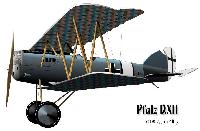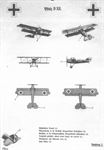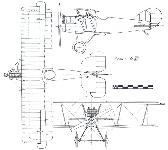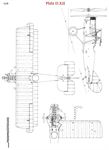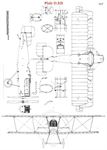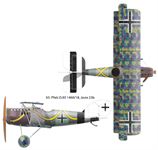
Описание
Страна: Германия
Год: 1918
Истребитель
В.Кондратьев Самолеты первой мировой войны
PFALZ D.XII
Истребитель "Пфальц" D.XII, разработанный Рудольфом Герингером в начале 1918 года, значительно отличался от своего предшественника. Стремясь снизить массу машины, одновременно сохранив прочностные характеристики, конструктор уменьшил габаритные размеры и переработал схему бипланной коробки. Самолет стал двухстоечным бипланом с N-образными стойками из профилированных стальных труб. Это способствовало облегчению конструкции, но увеличило лобовое сопротивление. Силовая схема фюзеляжа и оперения осталась прежней.
Первый полет прототипа состоялся в апреле 1918 г. Самолет испытывался с различными двигателями, но в итоге за ним закрепили 175-сильный "Мерседес" D.IIIa, так как весь объем выпуска более мощного 185-сильного BMW-III был зарезервирован для истребителя "Фоккер" D.VII, считавшегося более перспективным. Это не позволило новому "Пфальцу" раскрыть всех своих возможностей.
Тем не менее, благодаря протекции регионального правительства Баварии в июне 1918 г. D.XII был запущен в серию для оснащения баварских авиачастей. Общий объем заказов составил 750 экземпляров, из которых до конца войны успели построить около 550.
Самолет применялся на западном фронте и состоял на вооружении примерно 20 истребительных эскадрилий. Несмотря на то, что D.XII превосходил широко распространенный "Альбатрос" D.Va, он не завоевал авторитета у пилотов, наслышанных о гораздо более высоких достоинствах "Фоккера" D.VII. Кроме того, фронтовая служба "пфальцев" сопровождалась множеством аварий; в ходе эксплуатации выявилась недостаточная прочность шасси, которое часто ломалось при посадках.
К моменту подписания перемирия уцелело около 170 "пфальцев" D.XII. Часть из них была уничтожена по условиям Версальского договора, а остальные распроданы различным гражданским лицам и организациям.
ДВИГАТЕЛЬ: "Мерседес" D-IIIa (180 л.с.) или BMW-IIIa (185 л.с.).
ВООРУЖЕНИЕ: 2 синхр. LMG 08/15 "Шпандау".
ЛЕТНО-ТЕХНИЧЕСКИЕ ХАРАКТЕРИСТИКИ
Размах, м 9,00
Длина, м 6,35
Площадь крыла, кв.м 21,70
Сухой вес, кг 692
Взлетный вес, кг 897
Скорость максимальная, км/ч 180
Время подъема на высоту
2000 м, мин.сек 6,05
Потолок, м 5650
Описание:
- В.Кондратьев Самолеты первой мировой войны
- O.Thetford, P.Gray German Aircraft of the First World War (Putnam)
- W.Green, G.Swanborough The Complete Book of Fighters
- J.Herris Pfalz Aircraft of WWI (A Centennial Perspective on Great War Airplanes 5)
- Журнал Flight
Фотографии
-
J.Herris - Pfalz Aircraft of WWI /Centennial Perspective/ (5)
Bavarian Jadgstaffel 77 was perhaps one of the first units that received the Pfalz D.XII, since photographs indicate that the unit was supplied with at least two early-production machines with the 'rectangular' rudder. One of those is illustrated here,- the serial number was apparently 1394/18, though it is difficult to discern and 1354/18 is also a possibility. This D.XII displayed the silbergrau fuselage of the initial production machines, with five-color fabric on the wings. The unit emblem of Jasta 77b is thought to have been a blue tail, the exact shade of which is impossible to determine at this point. A portion of the nose may also have been painted blue, and the unknown pilot's personal marking of a black swastika appeared beneath the cockpit. Note the elongated cross on the rudder,- this is seen on other Jasta 77b D.XII machines, and was either an attempt to have the cross conform to the rudder proportions, or (less likely) a misapplication of a Kogenluft directive of 13 May 1918 which specified that the wing cross arms were to have a vertical/horizontal ratio of 5:4. The Balkenkreuz on the fuselage have been reduced in size from an earlier, fully-bordered form with neutral paint of undetermined color.
-
J.Herris - Pfalz Aircraft of WWI /Centennial Perspective/ (5)
Jasta 17 was issued some examples of the Pfalz D.XII, 1416/18 along them. This machine left the factory with a silbergrau fuselage and five-color fabric on the wings. Once it reached the Jagdstaffel, the unit marking of a dark nose section with white front was painted on. The dark unit color is depicted as dark blue; however, this remains unconfirmed, and the actual color may have been red, dark green, or even black. The tailplane was apparently painted the same dark color as the nose, and an individual marking of a white band encircled the fuselage behind the national insignia. The fin and rudder were white.
-
J.Herris - Pfalz Aircraft of WWI /Centennial Perspective/ (5)
Another Jasta 17 D.XII (serial number unknown) was marked in a manner very similar to 1416/18, with some significant individual differences. The unidentified pilot marked his aircraft with a black band along the center line of the fuselage, and personalized it further with the name 'Wildfang' in ornate white characters on the rear fuselage. Wildfang translates loosely as 'an unruly child, a madcap, especially a tomboy'; just the form of feminine nickname many a young airman would apply to his fighter aircraft in this war and those to come.
-
J.Herris - Pfalz Aircraft of WWI /Centennial Perspective/ (5)
An album of a Jasta 49 pilot (probably a Lt. Thiel) revealed this Pfalz D.XII 1437/18. The machine had a typical silbergrau fuselage and no visible special markings other than the dark-painted tailplane, elevators and (possibly) wheel covers. The dark tail may have been the unit marking of Jasta 49, and is here arbitrarily depicted as red (though other possibilities include blue, green, or even yellow). The usual printed camouflage fabric covered the wings. The unidentified Jagdflieger mounted a flare pistol and rack for cartridges on the starboard side of the cockpit. Fin may have been silbergrau.
-
J.Herris - Development of German Warplanes in WWI /Centennial Perspective/ (1)
Pfalz D.XII serving in Jasta 77. The silver-gray fuselage with five-color camouflage fabric on the flying surfaces are from the factory; the blue tail, nose, and wheel covers are the Jasta unit markings. The Pfalz D.XII could fly with the Fokker D.VII in all respects and was a good strong aircraft. However, the Fokker D.VII had better maneuverability and was easier to fly, so was greatly preferred by pilots.
-
J.Herris - Pfalz Aircraft of WWI /Centennial Perspective/ (5)
The photograph of Pfalz D.XII 1443/18 has been frequently published, but incomplete or erroneous information has often accompanied it. There is now no doubt that 1443/18 was assigned to Jasta 77b, and bore the unit's blue tail section with white rudder. Like the previous D.XII, this aircraft displayed a reduced cross on the fuselage and one of elongated form on the rudder. The unidentified pilot's personal badges included a black-bordered white band on the rear fuselage and a black 'Mercedes Star' beneath the cockpit, with a barely-discernible white border. A section of the nose and the wheel covers may have borne the unit's blue color as well.
-
В.Кондратьев - Самолеты первой мировой войны
Пфальц D.XII, осень 1918г.
-
J.Herris - Pfalz Aircraft of WWI /Centennial Perspective/ (5)
The same Jasta 49 photo album contained a shot of Pfalz D.XII 1445/18, which may well have been the aircraft of the album's owner, Lt. Thiel. The fuselage was again silver-gray with lozenge fabric wings. The fuselage displayed an interesting personal insignia of two black (?) vertical bands with a white zig-zag or lightning bolt marked between them. The fin was silver, with a white rudder, and the horizontal tail surfaces are once again tentatively depicted as red. Personal modifications included a small hole cut into the translucent windshield to facilitate aiming, a rear-view mirror on the center-section, and, yet again, a flare pistol and ammunition rack near the cockpit.
-
J.Herris - Pfalz Aircraft of WWI /Centennial Perspective/ (5)
The well-known photograph of Pfalz D.XII 1460/18, dated 6 January 1919, shows only the fuselage from the cockpit back, so much of this depiction is guesswork. The black and white bands on the rear fuselage and tail indicate that this machine once served in Jasta 23b. The camouflage colors depicted on the fuselage are based on another machine of the same unit, D.XII 2486/18, which was shot down behind Allied lines on 15 September 1918 to become the subject of a Ministry of Munitions report. This document stated that the fabric was the printed camouflage type, and... "the body painted dark purple from nose to rear of engine,- bluish-grey to the pilot's cockpit and a dark green shading to a light pea-green extending to the tail..." The photo of 1460/18 clearly shows another dark green area just ahead of the unit marking, as illustrated. The pilot's personal marking was a dark-bordered light snakeline band which crossed over the fuselage above the national insignia; this has been depicted as light yellow with a black border, but other interpretations are possible.
-
J.Herris - Pfalz Aircraft of WWI /Centennial Perspective/ (5)
While D.XII 2454/18 will be familiar to many enthusiasts, previous depictions and captions for this machine (including one originating from this writer) have been somewhat incorrect. Previously thought to be a Jasta 35b machine, it is now known that attribution is false. It may, in fact, have been from Bavarian Jasta 32, a supposition supported by what we might interpret as a black tail section - which was, for a time, the unit marking of Jasta 32b. It is likely that the horizontal stabilizers, elevators (which are, however, not visible in the photo) and adjacent fuselage areas were black; the fin, and undoubtedly the rudder, were white. The rest of the fuselage was spray-camouflaged in one of the typical patterns detailed above, the choice of colors illustrated being an arbitrary one. The unknown pilot's individual identification consisted of the letter 'K' and apparently '1'; the latter was definitely not a stripe that encircled the fuselage, but a letter. It is this writer's belief that these letters were white, and not the yellow usually seen, even though the light shade of the letters appears slightly darker than the factory-applied white of the fuselage cross border. Unfortunately, these initials cannot be matched to any appropriate Jasta 32b pilot known to the author - perhaps they referred to a lady friend.
-
J.Herris - Pfalz Aircraft of WWI /Centennial Perspective/ (5)
Pfalz D.XII 2486/18 is illustrated in what is thought to be its appearance at the time it was forced down behind British lines on 15 September 1918. The pilot, Lt.d.R. Paul Vogel, had been shot down by 2/Lt. Cameron of No. 1 Squadron and Capt. Staton and Lt. Mitchell of No. 62 Squadron. Vogel was taken POW but later died of his wounds. His D.XII was given the number G/HQ/6 , and the report on this machine gives the fuselage colors described above. There are four halftone photos of the wrecked machine, and they do show that the fuselage cross was over-painted with the camouflage paint, and the tail was decorated in Jasta 23b's black and white bands - the report describes the latter color as a 'creamy white'. From nose to tail, the fuselage was dark purple, bluish-gray, dark green and light green,- the underside was probably light blue or silver-gray. The wings were lozenge fabric covered.
-
J.Herris - Pfalz Aircraft of WWI /Centennial Perspective/ (5)
Pfalz D.XII of Vzfw. Marchner, Jasta 32b. By late 1918 Jasta 32b was using 'Bavarian Blue' markings, and the blue initial 'M' was Marchner's personal marking. The aircraft appears to be in the typical late Pfalz camouflage scheme with wings in five-color camouflage fabric.
-
J.Herris - Pfalz Aircraft of WWI /Centennial Perspective/ (5)
Pfalz D.XII 2600/18 is today preserved at the Australian War Memorial at Canberra, and is perhaps the most authentic of the four existing examples. The research of dedicated Australian historians Robert Waugh and Colin A. Owers has determined the original colors of 2600/18. Unlike 2685/18 and some others, 2600/18 had its camouflage colors wrapped entirely around the fuselage, with no light blue under surfaces; the plywood between the lower wing root fairings was clear-doped or varnished. Mr. Waugh's notes state that the nose was dark brown (7E6), slightly grayish olive green to the cockpit; around the cockpit dark green,- then light green, dark green, medium green, and a very dark brown at the end of the fuselage near the sternpost. Metal cowlings on the nose were khaki (a light chocolate brown). The top surface of the tailplane was apparently doped with a clear dope which had a brownish dye suspended or mixed in it, the under surface was finished with a creamy dope. Five-color camouflage fabric was used on the usual surfaces. The author and publishers wish to thank Colin Owers for the use of this information and the color photos of the restored aircraft.
-
J.Herris - Pfalz Aircraft of WWI /Centennial Perspective/ (5)
Many examples of the early production Pfalz D.XII left the factory in a similar finish to that noted on the D.VIII: fuselages and tailplanes doped in silbergrau, and five-color printed camouflage fabric on wings, fin, and elevators, with rudders painted white. However, most D.XII fighters that reached operational status displayed a multi-color shadow-shaded camouflage applied to the fuselage and tailplane. Fortunately, there is considerable data on these camouflage colors, from both reports on aircraft that were captured or turned over following the armistice, and from one of the four surviving examples of the type.
A contemporary report on a Pfalz D.XII (thought to be 2685/18) was discovered by British aircraft colors authority Ian Huntley, which included a general arrangement drawing of the aircraft upon which an unknown observer had painted apparently accurate colors. Since no photo of 2685/18 is known to this writer, the colors are illustrated here on 2690/18, of which three photos do exist. Approximations of the colors used, based on the Methuen color system, are listed in parentheses. The nose was purple (16F4), then medium gray to the cockpit (4C2), around the cockpit was dark green (26E3), then light green (27D4), and purple again and medium gray to the end of the fuselage. The underside of the fuselage was light blue (23A2/3) from nose to tail. The upper surface of the tailplane was brown (4D6), while the underside was the same light blue as the fuselage. Both the rudder and the wheel covers were white, and five-color fabric was applied to all the usual surfaces. These fuselage colors were probably sprayed on, though there is also motion picture film showing factory workers applying at least some of the colors by hand; at any rate, the colors generally merged into one another. -
J.Herris - Pfalz Aircraft of WWI /Centennial Perspective/ (5)
Pfalz D.XII 2695/18 turned up in Allied hands after the war and became the subject of several photographs. In these circumstances, details of its original German pilot and/or unit are obviously lacking, and much of the illustration is conjectural. It is arbitrarily depicted in the camouflage scheme described for the Canberra D.XII 2600/18, except that 2695/18 did have a pale blue underside to the fuselage. The tail section was painted an apparent light color, blue being a possibility; the nose cowling and wheel covers may have been the same color. The personal marking was a zig-zag lightning bolt on a dark band - black and yellow is but one logical possibility here.
-
В.Кондратьев - Самолеты первой мировой войны
"Пфальц" D.XII в стандартной для этого типа окраске, 1918г.
-
J.Herris - Pfalz Aircraft of WWI /Centennial Perspective/ (5)
Reconstructed from a poor-quality photo of a rather battered aircraft, this Pfalz D.XII illustration nonetheless depicts a most interesting machine. The only information available is that the photo originated with a German airman who served on a small German airfield at Enghien, Belgium; whether or not the D.XII also was located there is unconfirmed. This Pfalz was a rare example of a D.XII with a fuselage entirely over-painted in unit and personal markings. The whole fuselage was a solid dark color, here shown as a conditional black. The personal emblem was the feminine name 'Kuny' inscribed in large white characters. 'Kuny' was an affectionate abbreviation for 'Kunigunde' (the German equivalent of the French Cunegonde). The fin and rudder were white, and the wings almost certainly retained their printed five-color finish. The writer is indebted to Jacques de Ceuninck for supplying the photo.
-
J.Herris - Pfalz Aircraft of WWI /Centennial Perspective/ (5)
This Pfalz D.XII was the subject of an unidentified crash photo. The fuselage, including the fin, was painted entirely in a dark color which was most likely black (though, again, this is conjecture). The pilot's emblem, in white, was apparently based on the epaulette badge of the Fliegertruppe - a two-bladed propeller flanked by a pair of wings. The wings probably retained the five-color printed camouflage finish.
-
J.Herris - Pfalz Aircraft of WWI /Centennial Perspective/ (5)
As related in the text, the seven-victory ace Lt. Josef Raesch of Jagdstaffel 43 briefly flew the Pfalz D.XII seen here (serial number unknown). The Pfalz had a silver-gray fuselage, and the entire tail section was decorated in white - the unit marking of this Jasta. Aircraft of this unit also bore small personal identification numbers on their fin in black, a '10' in the case of Raesch's D.XII. This aircraft was damaged beyond repair during a British bombing and strafing raid, and the only available photo of it shows Raesch and his comrades happily 'riding' the scrapped and wingless fuselage. However, the wings would certainly have been covered in the usual five-color lozenge fabric.
-
W.Green, G.Swanborough - The Complete Book of Fighters
A Pfalz D XII photographed at Riverside, California, in 1959 when owned by Frank Tallman.
-
J.Herris - Pfalz Aircraft of WWI /Centennial Perspective/ (5)
Pfalz D.XII in the Musee de I'Air.
-
J.Herris - Pfalz Aircraft of WWI /Centennial Perspective/ (5)
Pfalz D.XII in the National Air & Space Museum in the scheme used in the movie Dawn Patrol; the red should be black, (all photos via Greg VanWyngarden)
-
J.Herris - Pfalz Aircraft of WWI /Centennial Perspective/ (5)
Restored Pfalz D.XII at the Champlin Fighter Museum; this collection is now at the Museum of Flight in Seattle. The aircraft is in the late camouflage scheme, (courtesy Greg VanWyngarden)
-
J.Herris - Pfalz Aircraft of WWI /Centennial Perspective/ (5)
Restored Pfalz D.XII at the Champlin Fighter Museum; this collection is now at the Museum of Flight in Seattle. The aircraft is in the late camouflage scheme, (courtesy Greg VanWyngarden)
Example wise: Daimler D.IIIa engines were widely used. 12,000 engines were installed like in the Pfalz D.XII. -
J.Herris - Pfalz Aircraft of WWI /Centennial Perspective/ (5)
Pfalz D.XII 2600/18 in the Australian War Memorial after restoration (courtesy Colin Owers)
-
J.Herris - Pfalz Aircraft of WWI /Centennial Perspective/ (5)
Pfalz D.XII 2600/18 in the Australian War Memorial after restoration (courtesy Colin Owers)
-
J.Herris - Pfalz Aircraft of WWI /Centennial Perspective/ (5)
Closeup of restored Pfalz D.XII 2600/18 showing the rigging plate on the left side of the fuselage.
-
J.Herris - Pfalz Aircraft of WWI /Centennial Perspective/ (5)
This Pfalz D.IIIa with SPAD-like wing configuration was an experimental type leading to the Pfalz D.XII. It has the standard engine and armement of the D.IIIa; 160 hp Mercedes D.III engine and two Spandau LMG 08/15 machine guns. Although ear radiators had been banned since November 1916 for operational aircraft, they were often used on prototypes because they were faster to obtain and install than a specially designed wing or nose radiator.
-
J.Herris - Pfalz Aircraft of WWI /Centennial Perspective/ (5)
Another Pfalz D.IIIa with 'SPAD' wing configuration. With the exception of the ear radiators and lack of N-struts, this aircraft looks like the early production Pfalz D.XII.
-
J.Herris - Pfalz Aircraft of WWI /Centennial Perspective/ (5)
Taken after the switch to Balkenkreuz in mid-March 1918, this photograph shows the definitive Pfalz D.XII prototype with the characteristic N-struts and nose radiator. All control surfaces are balanced to reduce control forces, thereby improving maneuverability. The square early fin was replaced by a curved fin and rudder early in production.
-
J.Herris - Pfalz Aircraft of WWI /Centennial Perspective/ (5)
Pfalz D.XII prototype or early production machine.
-
Сайт - Pilots-and-planes /WWW/
Pfalz D.XII prototype or early production fighter.
-
J.Herris - Pfalz Aircraft of WWI /Centennial Perspective/ (5)
An early production Pfalz D.XII with rectangular fin at the Pfalz factory. Pfalz test pilot Gustav Bauer stands at far right.
Pfalz test pilot, Vizefeldwebel Otto Angst watching the mechanics prepare an early production D.XII for flight test. -
J.Herris - Pfalz Aircraft of WWI /Centennial Perspective/ (5)
Pfalz test pilot Gustav Bauer sits astride a Pfalz D.XII; the other men are not known.
-
J.Herris - Pfalz Aircraft of WWI /Centennial Perspective/ (5)
Pfalz D.XII in bogus markings for making the 1930 movie Dawn Patrol.
-
Журнал - Flight за 1919 г.
После войны D XII испытывался в странах Антанты и в США, куда было переправлено несколько самолетов. В настоящее время в музеях сохранилось 4 "пфальца"
A PFALZ SCOUT. - This machine was one of the first to be surrendered under the Armistice terms. -
В.Кондратьев - Самолеты первой мировой войны
"Пфальц" D.XII, сохранившийся до наших дней в виде музейного экспоната.
-
J.Herris - Pfalz Aircraft of WWI /Centennial Perspective/ (5)
Late-production Pfalz D.XII photographed postwar
-
J.Herris - Pfalz Aircraft of WWI /Centennial Perspective/ (5)
Pfalz D.XII turned over to the Americans as part of the armistice terms, photographed at Koblenz.
-
Журнал - Flight за 1919 г.
A batch of surrendered Pfalz D XII German aeroplanes
-
J.Herris - Pfalz Aircraft of WWI /Centennial Perspective/ (5)
Poor quality but interesting photo of Pfalz D.XII "Kuny" of an unknown unit. Apparently it had flipped over on its back after landing, damaging the fin, rudder, and left aileron. The fuselage is probably black. "Kuny" is short for the feminine name"Kunigunde."
-
J.Herris - Pfalz Aircraft of WWI /Centennial Perspective/ (5)
Pfalz test pilot Otto Augst prepares for take-off in an early production Pfalz D.XII, 1918. The cross outlines and weight table have not yet been added. The rectangular fin is covered in lozenge camouflage fabric.
-
J.Herris - Pfalz Aircraft of WWI /Centennial Perspective/ (5)
The Pfalz D.XII 1346/18 is an early production example with squared-off fin and rudder; later production aircraft had a rounded fin and rudder. Power for D.XII production aircraft was the Mercedes D.IIIa/av/avu series of engines.
-
J.Herris - Pfalz Aircraft of WWI /Centennial Perspective/ (5)
Lt. Rudolf Fuchs of Jasta 77b with his Pfalz D.XII 1346/18.The unit marking is a blue tail.This early production machine had the rectangular fin and rudder. For better cooling the radiator has deflectors and holes have been cut in the lower cowling. Fuchs wears a parachute harness; he scored one victory, a Spad, on 25 Sept. 1918.
-
J.Herris - Pfalz Aircraft of WWI /Centennial Perspective/ (5)
Pfalz D.XII 1350/18 in late-style camouflage is unloaded during a Jagdstaffel 35b move to a new airfield.
-
J.Herris - Pfalz Aircraft of WWI /Centennial Perspective/ (5)
Pfalz D.XII, perhaps 1372/18, with black fuselage and winged propeller marking, probably based on the shoulder strap badge of the Flying Troops. Jasta unknown.
-
J.Herris - Development of German Warplanes in WWI /Centennial Perspective/ (1)
The Pfalz D.XII was another good, solid Pfalz design over-shadowed by its competition that never made a name for itself. But one manifestation of Bavaria's desire for autonomy exists today; the BMW company, which was created from the old Bavarian Rapp engine company in 1917. The Pfalz D XII (serial 1375/18) is at the Second Fighter Competition and had the 200 hp Mercedes D.IIIau over-compressed engine.
-
J.Herris - Pfalz Aircraft of WWI /Centennial Perspective/ (5)
Pfalz D.XII 1375/18 powered by the 200 hp Mercedes D.IIIau over-compressed engine and fitted with the rounded fin and rudder used on most D.XII production machines. It is at the Second Fighter Competition at Adlershof in May-June 1918. Barographs are mounted on the outer wing struts for climb measurements.
-
J.Herris - Pfalz Aircraft of WWI /Centennial Perspective/ (5)
Pfalz D.XII 1394/18 probably of Jasta 77b. This early production machine had the early, rectangular fin and rudder. The cross on the fuselage has been altered from the fully-bordered style. An anemometer is mounted on the wing strut. The swastika was a common Nordic good luck symbol in those days before formation of the Nazi party post-war.
-
J.Herris - Pfalz Aircraft of WWI /Centennial Perspective/ (5)
Pfalz D.XII 1416/18 of Jasta 17. It is in factory finish of printed five-color lozenge camouflage fabric on the wings and silver-gray fuselage. The white radiator and dark (blue?) front fuselage are the Jasta 17 unit markings, and the white fuselage band is the pilot's individual marking.
-
J.Herris - Pfalz Aircraft of WWI /Centennial Perspective/ (5)
Pfalz D.XII 1425/18 in standard production colors and markings and final production form with large cowl openings, radiator with deflection plate, and nose ventilation openings.
-
J.Herris - Pfalz Aircraft of WWI /Centennial Perspective/ (5)
Pfalz D.XII 1437/18 of Jasta 49.The dark (red?) tailplane may be the unit marking; no personal markings are visible.
-
J.Herris - Pfalz Aircraft of WWI /Centennial Perspective/ (5)
Pfalz D.XII 1443/18 of Jasta 77b. The unit marking is the blue tail.The unknown pilot's personal marking includes the black Mercedes star with white outline on the fuselage by the cockpit and the white fuselage band outlined in black. The fuselage cross is in a late style.
The Pfalz D XII was another newcomer to the front in the last months of the war, having been selected for production as a result of its performance in the second of the 1918 Adlershof fighter competitions. At Adlershof, no less than three Pfalz D XII precursors had been entered, each having a different engine, with the 180hp Mercedes DIIIa being chosen to power the production aircraft. Readily distinguishable from the Fokker D VII by it second bay, or set of interplane struts, the twin 7.92mm Spandau armed Pfalz D XII started to enter operational service in September 1918, examples of it going to ten front-line Jastas. Initially seen as second best to the Fokker D VII, the D XII, with its 120mph top level speed at sea level proved slightly faster than the Fokker, which it could also outdive. However, perhaps the most endearing quality possessed by the Pfalz fighter was its ability to withstand a great deal of combat damage and still get its pilot home. With production only just having started up, only 90 to 100 D XIIs are thought to have been completed at the time of the Armistice. -
J.Herris - Pfalz Aircraft of WWI /Centennial Perspective/ (5)
Pfalz D.XII 1445/18 of Jasta 49. The dark (red?) tailplane may be the unit marking, while the black fuselage bands with white zig-zag is a personal marking.
-
J.Herris - Pfalz Aircraft of WWI /Centennial Perspective/ (5)
Final defeat. This scene, taken at Cologne in January 1919, shows the remains of a Pfalz D XII in the foreground and a stack of Albatros fuselages.
Pfalz D.XII 1460/18 ready for destruction early in 1919. The black and white tailplane indicate this D.XII was from Jasta 23b. Albatros fuselages are stacked for burning in the background. -
Сайт - Pilots-and-planes /WWW/
Pfalz D.XII 1460/18 in Allied hands after the war, 6 January 1919. Black and white stripes painted in spanwise manner on the tailplane and rear fuselage (not visible in this view) provide evidence that this Pfalz once served in Jasta 23b. In the background are piles of Albatros fighter fuselages turned over in accordance with the Armistice specifications
-
Сайт - Pilots-and-planes /WWW/
Pfalz D.XII 1481/18
-
Сайт - Pilots-and-planes /WWW/
"Пфальц" D.XII с заводским номером 1491/18.
-
J.Herris - Pfalz Aircraft of WWI /Centennial Perspective/ (5)
Pfalz D.XII 1504/18 of Jasta 73 at Remy airfield.
-
J.Herris, J.Leckscheid - Fokker Aircraft of WWI. Vol.5: 1918 Designs Part 2: D.VII & E.V/D.VIII /Centennial Perspective/ (55)
The Jagdstaffeln were constantly on the move, and when they were transferred to a more distant location aircraft were disassembled for transport by rail or truck. Here, the fuselage of Fok.D VII.(O.A.W.) 4489/18 from Jagdstaffel 32b "E" is seen next to Pfalz D.XII 2454/18. The small circular maintenance door that was introduced on the third O.A.W. batch can be seen well here, below the "cheese grater" cooling louvers. (Peter M. Grosz Collection/STDB)
Другие самолёты на фотографии: Fokker D.VII / V11 / V18 / V22 / V24 - Германия - 1917
-
J.Herris - Pfalz Aircraft of WWI /Centennial Perspective/ (5)
Vzfw. Ludwig Marchner of Jasta 32b poses with his Pfalz D.XII 2525/18 wearing his personal monogram 'M'. The fin and perhaps the horizontal tail are white.
-
J.Herris - Pfalz Aircraft of WWI /Centennial Perspective/ (5)
Vzfw. Ludwig Marchner of Jasta 32b poses with his Pfalz D.XII 2525/18 wearing his personal monogram 'M'.
-
Сайт - Pilots-and-planes /WWW/
Pfalz D.XII 2454/18 with the Pfalz factory in the background.
-
J.Herris - Pfalz Aircraft of WWI /Centennial Perspective/ (5)
Pfalz D.XII 2600/18 preserved at the Australian War Memorial.
-
J.Herris - Pfalz Aircraft of WWI /Centennial Perspective/ (5)
Two Pour le Merite aces visit the Pfalz factory with Pfalz D.XII 2603/18 for a backdrop for possible use by JG I. From left to right: Oblt. Siebert, Jasta 10 leader Lt. Hans Klein, factory owner Alfred Eversbusch, Jasta 4 leader Lt. Ernst Udet, Geschwader technical officer Lt. Konstantin Krefft, Austrian kuk Oblt. Lucas, and Dr. Moericke, Burgermeister of Speyer. Klein had been CO of Jasta 10, scored 22 victories, and was awarded the Pour le Merite. He was wounded in combat, losing his right thumb, on 19 Feb. 1918 and saw no further combat. Udet, the second-highest scoring ace, also won the Pour le Merite. JG I declined delivery of the aircraft.
-
Сайт - Pilots-and-planes /WWW/
A factory photo of Pfalz D.XII 2624/18.
-
Сайт - Pilots-and-planes /WWW/
A factory photo of Pfalz D.XII 2624/18.
-
Сайт - Pilots-and-planes /WWW/
A factory photo of Pfalz D.XII 2624/18.
-
J.Herris - Pfalz Aircraft of WWI /Centennial Perspective/ (5)
Pfalz D.XII 2666/18 at the Daimler aircraft factory.
-
J.Herris - Pfalz Aircraft of WWI /Centennial Perspective/ (5)
A standard production Pfalz D.XII was photographed at the Daimler factory, possibly for Daimler to prepare to repair fighters damaged in combat. In some photos the wood ladder supporting the tail has been retouched out of the image on the originals. A meter bar is in some of the photos for scale.
-
J.Herris - Pfalz Aircraft of WWI /Centennial Perspective/ (5)
A standard production Pfalz D.XII was photographed at the Daimler factory, possibly for Daimler to prepare to repair fighters damaged in combat. In some photos the wood ladder supporting the tail has been retouched out of the image. A meter bar is included in some of the photos for scale.
-
Сайт - Pilots-and-planes /WWW/
Pfalz D.XII 2666/18 at the Daimler aircraft factory.
-
J.Herris - Pfalz Aircraft of WWI /Centennial Perspective/ (5)
Pfalz D.XII 2666/18 at the Daimler aircraft factory.
-
Сайт - Pilots-and-planes /WWW/
Pfalz D.XII 2666/18 at the Daimler aircraft factory.
-
J.Herris - Pfalz Aircraft of WWI /Centennial Perspective/ (5)
Pfalz D.XII 2670/18 was shipped to Canada after the war. Lt. de Plessierof No.1 Squadron RCAF is in the cockpit. This aircraft is fitted with stronger undercarriage struts.
-
Сайт - Pilots-and-planes /WWW/
D.XII 2670/18 taken as war booty
-
J.Herris - Pfalz Aircraft of WWI /Centennial Perspective/ (5)
Pfalz D.XII 2675/18 of Jasta 71 in Allied hands at Habsheim wears the late-style sprayed camouflage.
-
Сайт - Pilots-and-planes /WWW/
Один из последних "пфальцев" D.XII, собранных в конце войны. Эта машина не успела попасть на фронт и в числе других была выдана французам по условиям компьеньского мирного соглашения.
-
J.Herris - Pfalz Aircraft of WWI /Centennial Perspective/ (5)
Pfalz D.XII 2690/18, a late-production fighter, was handed over to the French as part of the armistice terms.
-
J.Herris - Pfalz Aircraft of WWI /Centennial Perspective/ (5)
Pfalz D.XII 2695/18 in late-style camouflage with crosses obscured is in Allied hands postwar; a Sopwith Camel is in the background in the top photo. Barely visible is the zig-zag vertical band on the fuselage.
Другие самолёты на фотографии: Sopwith Camel - Великобритания - 1916
-
J.Herris - Pfalz Aircraft of WWI /Centennial Perspective/ (5)
Pfalz D.XII 2695/18 in late-style camouflage with crosses obscured is in Allied hands postwar. Barely visible is the zig-zag vertical band on the fuselage.
-
Сайт - Pilots-and-planes /WWW/
A photo of Pfalz D.XII 2695/18 turned over to the American Air Service in Trier.
-
Сайт - Pilots-and-planes /WWW/
A photo of Pfalz D.XII 2695/18 turned over to the American Air Service in Trier.
-
Сайт - Pilots-and-planes /WWW/
A photo of Pfalz D.XII 2695/18 turned over to the American Air Service in Trier.
-
J.Herris - Pfalz Aircraft of WWI /Centennial Perspective/ (5)
Late-production Pfalz D.XII 2967/18 was given to Japan as war booty.
-
J.Herris - Pfalz Aircraft of WWI /Centennial Perspective/ (5)
Pfalz D.XII photographed postwar with spurious markings.
-
J.Herris - Pfalz Aircraft of WWI /Centennial Perspective/ (5)
Pfalz D.XII 9693/18 in French hands after the war as part of the Armistice conditions.
-
J.Herris - Pfalz Aircraft of WWI /Centennial Perspective/ (5)
Pfalz D.XII in late camouflage photographed in November 1918.
-
J.Herris - Pfalz Aircraft of WWI /Centennial Perspective/ (5)
Pfalz D.XII Wildfang (meaning tomboy or unruly child) of Jasta 17 provides a close-up of the engine cowling, oversized windscreen, rear-view mirror, and flare gun tube beside the cockpit.
-
J.Herris - Pfalz Aircraft of WWI /Centennial Perspective/ (5)
Moving day at Jagdgruppe 8b, commanded by von Schleich, that included Jastas 32b and 35b. Pfalz D.XII and Fokker D.VII fighters of Jasta 35b are being unloaded from a train at Bouchain on 25 September 1918 to move to their new airfield at Buhl. The Fokker D.VII with the "H"on a dark band is 4487/18; it was usually flown by Lt.d.R. F. Stoer.The D.XII with the"K1"on the side is 2454/18; it and the adjacent D.VII marked "E"were either Jasta 32b or Jasta 35b. When the entire Jagdgruppe moved it would typically be via train, saving wear on the aircraft.
Другие самолёты на фотографии: Fokker D.VII / V11 / V18 / V22 / V24 - Германия - 1917
-
J.Herris - Pfalz Aircraft of WWI /Centennial Perspective/ (5)
A Pfalz D.XII of Jasta 35b in flight showing the white upper wing chevron seen on many Jasta 35b aircraft. A similar black marking may have been painted underneath the lower wings.
-
J.Herris - Pfalz Aircraft of WWI /Centennial Perspective/ (5)
Lt. Josef Raesch and fellow pilots of Jasta 43 demonstrate a sense of humor after Raesch's Pfalz D.XII was destroyed in a British bombing raid on their airfield on 16 August 1918. Raesch, a 7-victory ace, is third from right. He survived being shot down in flames by parachute. He shot down two ace flight commanders of No.29 Sqdn., RAF, Capt. Hoy (13 victories, POW) and Capt. Wareing (9 victories, KIA). His Pfalz has a white tail with "10" on the fin.
-
J.Herris - Pfalz Aircraft of WWI /Centennial Perspective/ (5)
Pfalz D.XII of Jasta 49 in late camouflage after a bad landing. The radiator is painted silver.
-
J.Herris - Pfalz Aircraft of WWI /Centennial Perspective/ (5)
Pfalz D.XII of Jasta 71 with an Albatros D.Va in the background.
Другие самолёты на фотографии: Albatros D.V/D.Va - Германия - 1917
-
J.Herris - Pfalz Aircraft of WWI /Centennial Perspective/ (5)
Vzfw. Rudolf Nebel of Jasta 73 at Remy with his Pfalz D.XII. Nebel scored one confirmed victory, a Spad, on 21 August 1918. The lower nose of his Pfalz has additional cooling intakes.
-
J.Herris - Pfalz Aircraft of WWI /Centennial Perspective/ (5)
Pfalz D.XII at a Marine Feld Jasta. Unfortunately, the names of the men are not known.
-
J.Herris - Pfalz Aircraft of WWI /Centennial Perspective/ (5)
Early production Pfalz D.XII being built.
-
J.Herris - Pfalz Aircraft of WWI /Centennial Perspective/ (5)
Factory scenes; building the Pfalz D.XII.
-
J.Herris - Pfalz Aircraft of WWI /Centennial Perspective/ (5)
Pfalz workmen fitting a wing to a Pfalz D.XII.
-
J.Herris - Pfalz Aircraft of WWI /Centennial Perspective/ (5)
Armorers mounting guns in Pfalz D.XII fuselages.
-
M.Dusing - German Aviation Industry in WWI. Volume 1 /Centennial Perspective/ (84)
Final assembly of Pfalz D.XII fighters with Daimler D.IIIa engines.
-
J.Herris - Pfalz Aircraft of WWI /Centennial Perspective/ (5)
Pfalz D.XII fuselage shells awaiting assembly.
-
J.Herris - Roland Aircraft of WWI /Centennial Perspective/ (9)
Building a Pfalz fuselage; minimum framing was needed for the Wickelrumpf fuselage shell.
-
R.Kosin - The German Fighter since 1915 /Putnam/
Pfalz fuselage construction.
-
J.Herris - Pfalz Aircraft of WWI /Centennial Perspective/ (5)
Pfalz D.XII 2600/18 nose and radiator details.
-
J.Herris - Pfalz Aircraft of WWI /Centennial Perspective/ (5)
Pfalz D.XII 2486/18 of Jasta 23b force-landed in British lines and was subject to a Ministry of Munitions report. It has been heavily souvenired.
-
Журнал - Flight за 1919 г.
The port side of the D XII Pfalz
-
Журнал - Flight за 1919 г.
Front view of D XII Pfalz. Note radiator and sloping 'N' struts
-
Журнал - Flight за 1919 г.
Three-quarter front view of D XII Pfalz
-
Журнал - Flight за 1919 г.
Three-quarter rear view of the D XII Pfalz
-
J.Herris - Pfalz Aircraft of WWI /Centennial Perspective/ (5)
Derelict German aircraft after the war. The Pfalz D.III fuselage second from left carries an interesing marking. The Pfalz D.XII next to it wears late camouflage.
Другие самолёты на фотографии: Pfalz D.III/D.IIIa - Германия - 1917
-
Журнал - Flight за 1919 г.
Some constructional details of D XII Pfalz. - 1. Attachment of bottom wing spar to body. 2. Top plane section compared with R.A.F. 14. 3. Spars and ribs. 4. Reinforcement of wing spars at point of attachment of struts. 5. Strong support of false spar, to which aileron is hinged. 6. Spar fitting. 7. Diagrams of struts. 8. Tubular support for pilot's seat.
-
Журнал - Flight за 1919 г.
Some more constructional details of D XII Pfalz. - 9. Framework construction of rear of fuselage. 10. Sketch shows long hinge-bolt of elevator. 11. The radiator. 12. Main petrol tank. 13. Controls. 14. Diagram of gun mounting.
-
J.Herris - Pfalz Aircraft of WWI /Centennial Perspective/ (5)
German Pfalz D.XII recognition chart.
-
Jane's All The World Aircraft 1919 /Jane's/
Pfalz Scout. Type D.XII.
-
W.Green, G.Swanborough - The Complete Book of Fighters
The D XII began to reach the Front in quantity in August 1918, but proved unpopular.
-
Журнал - Flight за 1919 г.
General arrangement drawings of Pfalz Scout D XII
-
В.Кондратьев - Самолеты первой мировой войны
Pfalz D.XII
-
J.Herris - Pfalz Aircraft of WWI /Centennial Perspective/ (5)
Pfalz D.XII 2690/18.
-
J.Herris - Pfalz Aircraft of WWI /Centennial Perspective/ (5)
Pfalz D.XII 1460/18, Jasta 23b.






